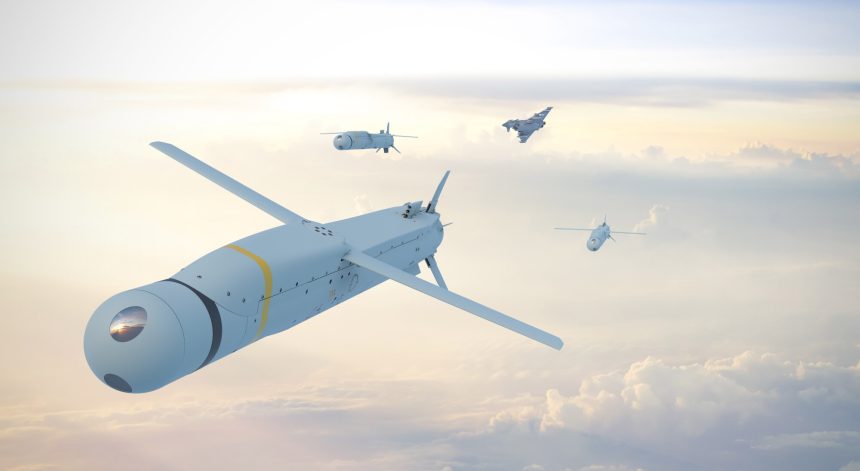MBDA has revealed a new variant of the SPEAR weapon system that provides a low-cost addition to the Royal Air Force’s arsenal.
First shown off last week at DSEI, the new SPEAR Glide weapon is based on the existing SPEAR-3 and SPEAR-EW airframes, but without the TJ-150 turbojet propulsion. Instead, it will rely on the carrying aircraft’s speed and height to get the weapon into the correct position for launch, where it will then glide towards the designated target.
The use of the common SPEAR airframe allows MBDA to leverage the kinematics of a missile that is already being integrated onto RAF platforms. Moreover, this would speed up the development and, ultimately, the fielding to the operational units.
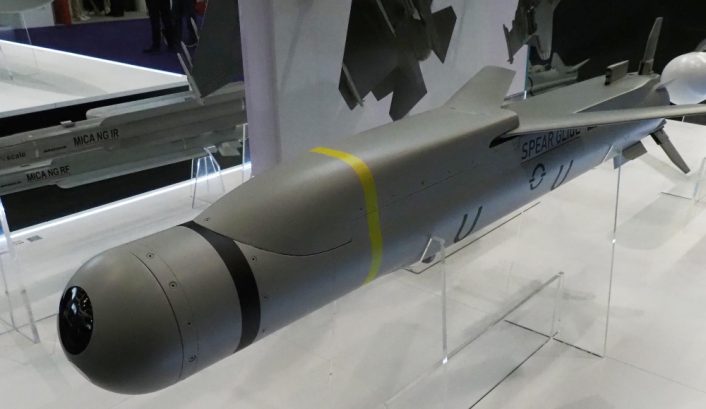
Spear Glide can fit into the same launchers as its sister missiles, cutting integration costs and providing a rapidly producible weapon system. Typhoons using external launchers will be able to carry three weapons on each launcher, whilst F-35 Lightnings will be able to carry four weapons in each bomb bay.
New at #DSEI2025 is #SPEAR Glide!
🎥 Watch the video to explore this innovative solution designed for high mass deployment, offering a cost-effective approach to saturate and overwhelm enemy air #defences#MBDA #innovation #SpearFamily pic.twitter.com/l7qbqIMcNJ
— MBDA (@MBDAGroup) September 11, 2025
Additionally, the lack of an engine gives SPEAR Glide the ability to house a much larger warhead, allowing the destruction of more hardened targets, such as command bunkers or ammunition depots. Whilst the lack of propulsion does limit the range of the weapon, it is reportedly in the same 80km range bracket that other glide bombs possess, giving the launcher aircraft a limited stand-off capability.
Its guidance package is to be dual-mode, similar to the Brimstone missile currently in service with the RAF, combining electro-optical/infrared imaging with semi-active laser guidance. However, it is also to use image-based navigation and a form of artificial intelligence to locate the target area even when navigational GPS is denied by electronic warfare.
SPEAR Glide is designed to be used in conjunction with its jet powered counterparts, complementing SPEAR-3 that has a longer range and a smaller warhead. SPEAR-3 would be used to take out high value targets from afar, destroying radars and surface to air missiles (SAM) that can threaten the strike package.
SPEAR GLIDE breaks cover in London as MBDA showcases its weapon prowess #avgeek #DSEI2025 #DSEI https://t.co/BUDYaH9H3Z pic.twitter.com/gdbCe6Yoho
— Tim Robinson (@RAeSTimR) September 12, 2025
This would then allow the deploying aircraft to get within range of an opponent’s hardened targets, where a larger number of cheaper SPEAR Glide can be unleashed to overwhelm the target and its point defences. SPEAR-EW would be used in conjunction with both weapons, providing an electronic warfare defence against an opponent’s radars, jamming them and allowing SPEAR-3 and SPEAR Glide to hit their targets with minimal interference.
Notably, SPEAR Glide is designed to be more affordable than the turbojet equipped missile variants, allowing for a larger stockpile of precision strike weapons than is currently available. Currently, the UK is looking for lower cost options to supplement its higher end missile systems in order to provide their military with a larger magazine that is more able to deal with sustained peer level conflicts. Here a possible war against Russia is the main focus with low-cost weapons necessary to match the scale and the speed of weapons production currently seen by both Ukraine and the Russian Federation.

The current stockpile of weapons used by the UK is rather small and limited in its variety, suited far more for a peacetime military focused on just a few common weapon systems. For long range precision strike the UK currently uses the Storm Shadow air launched cruise missiles (ALCM), Tomahawk land attack cruise missiles (TLAM) and the Naval Strike Missile for anti-ship engagements.
However, at shorter ranges the RAF is limited to the air launched Brimstone anti-armour missile and the 500lb Paveway IV guided bomb. This is not an extensive stockpile.
Whilst the SPEAR-3 is intended for use on British and Italian F-35B Lightning fighters, integration of the weapons has yet to be achieved. It is hoped that by providing SPEAR Glide as a complimentary weapon, the stockpile of available weapons on F-35 can be rapidly expanded. This factor is critical for the UK in particular.

During the 2011 NATO intervention in Libya, the number of available Brimstone missiles dropped to single figures due to the high intensity of the conflict, necessitating the use of hundreds of missiles in the space of a few short weeks.
Whilst the RAF was able to carry on the campaign due to rapid deliveries of freshly manufactured missiles from MBDA, it exposed a critical weakness in the RAF, as it could quickly run out of offensive weapons during combat. For context, the stockpile of a few hundred missiles was run through by a combined total of only 16 Tornado GR4 fighter bombers.
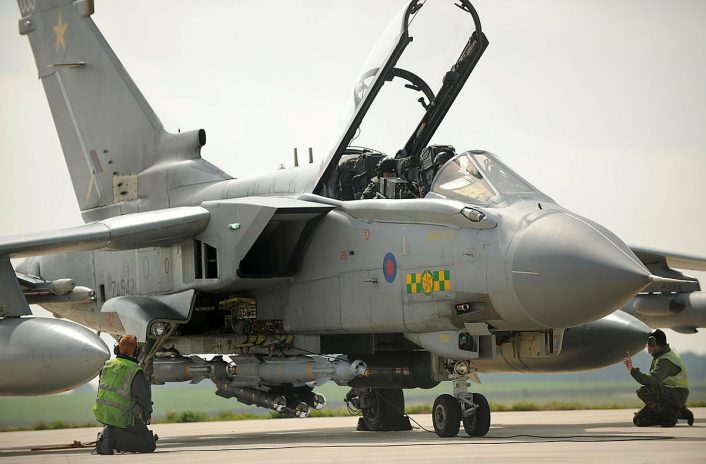
SPEAR Glide proposes a solution to this stockpile crisis, providing the RAF a larger number of available weapons that are readily integrated onto existing Typhoon and Lightning fighters. Fitting snugly in the British Government’s commitment to increasing the UK’s existing stockpile of munitions laid out in the 2025 Strategic Defence Review, SPEAR Glide adds a new, much needed weapon to this arsenal.
Furthermore, the CEO of MBDA Eric Beranger stated:
“SPEAR GLIDE embodies MBDA’s commitment to a comprehensive, efficient, integrated weapons portfolio. By offering a lower-cost, higher mass option that fits seamlessly into our family of systems, we are enhancing flexibility and value for sovereign capabilities.”
Why a glide bomb?
To put it bluntly, for Ukraine, Russian glide bombs have been a menace on the battlefield.
Since early 2023, the Russian Air Force (VKS) has been deploying large numbers of UMPK glide bombs against the Ukrainian military. They have an in-built GLONASS guidance system (Russian equivalent of GPS) and extendable wings that allow for precise attacks against Ukrainian positions, without risking the attacking aircraft, at an affordable price.
At the start of the war, Russia had a large stockpile of unguided bombs that could not yet be leveraged against Ukraine due to the VKS’ inability to operate in the Ukrainian interior as a result of the preponderance of Ukraine’s SAM network. Now, with the UMPK add-on kits, the VKS has become relevant on the battlefield once again.
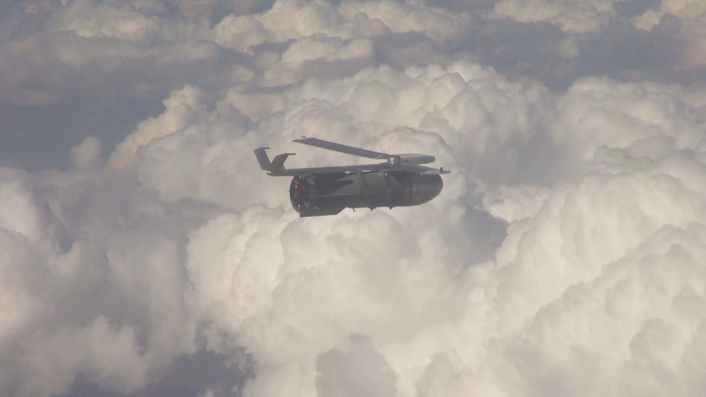
From ranges up to 100km away from the frontline, VKS fighter bombers such as the Su-34 have been able to target Ukrainian positions within the relative safety of Russian held territory. When the FAB-500 UMPK first entered the scene, there was little the Ukrainians could do to stop them, beyond shooting down the fighters carrying the weapons beyond the line of contact.
However, only rare long range SAMs such as the MIM-104 Patriot or the S-300 had the range to strike them. This in turn exposed those SAMs to ballistic missile and anti-radiation strikes, with a number of examples lost in the months after their introduction.
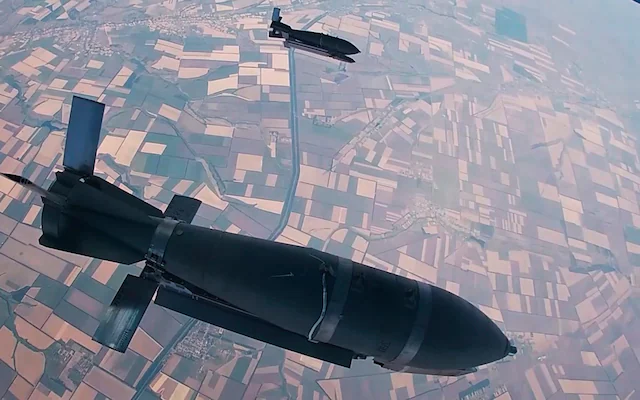
Failing to stop the glide bomb threat was significant, especially around the city of Avdiivka, as in early 2024 there were on average 80 glide bomb strikes a day against Ukrainian strong points in the city. This onslaught was deemed to be the most significant factor in the city’s fall that year, as Ukraine had no defence for its forces within the city.
The bombing was relentless throughout the battle, with Ukrainian positions fixed in place by infantry assaults, before being hit from the air by glide bombs. The cheap nature of the bombs and their guidance kits made this repeatable on a grand scale, and they remain a problem for Ukraine still in 2025.
A FAB-3000 Glide Bomb strike on a temporary deployment point for the Armed Forces of Ukraine (AFU). pic.twitter.com/9z9aJO1lpB
— OSINTWarfare (@OSINTWarfare) June 6, 2025
On the other hand, Ukraine has also made use of glide bombs in the form of the French AASM Hammer rocket propelled bomb. Dropped from Mig-29 and Su-25 fighters, the Ukrainians have achieved some great success with the weapon, using them during their 2024 offensive into the Kursk region.
At high altitude these weapons have a range of around 80km similar to SPEAR Glide, but at low levels this drops down to between 20 to 25km.
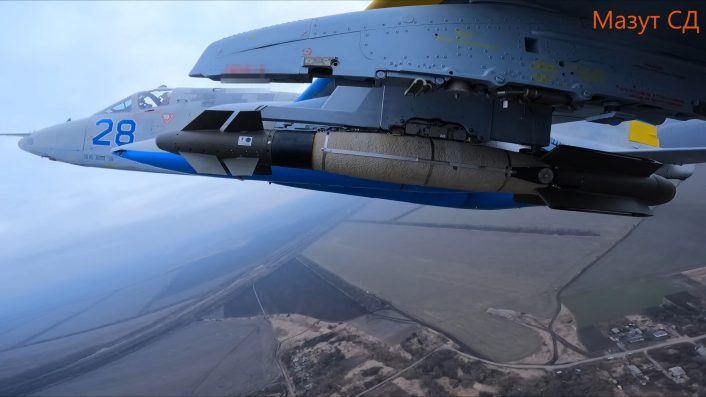
These weapons are also relatively inexpensive, relying on unguided Mk 82 bombs from the U.S. as the core explosive, which have been produced in significant quantities over their many years in use. Whilst the guidance and rocket kits are more expensive than their Russian counterparts, they are far more accurate allowing for fewer required bombs to hit a single target.
As a result of their battlefield use and reported success in targeting high value Russian targets, the French government has decided to ramp up production of the glide bomb, taking the number of weapons produced above the reported 2025 target of 1,200 guidance kits. This represents a significant boost for Ukraine’s defences, although the production number is still limited compared to the Russian target of 75,000 UMPK guidance kits for 2025.
More must be done for Europe and the U.S. to increase their production of similar weapons if they are to match Russian firepower and properly equip both Ukraine and themselves.
💥 Ukraine destroyed a bridge over the Konka river to stop a Russian assault in Kherson.
This could be the work of an American GLSDB long-range glide bomb launched by an F-16.
Ukraine received a new batch of these bombs with updated electronics to resist Russian countermeasures. pic.twitter.com/uXNjvQj2mV
— Igor Sushko (@igorsushko) March 15, 2025
Spear Glide may be the answer to this, or at least for the UK, giving the RAF the firepower it needs at a sustainable level for peer level conflicts. The weapon could be a game changer for the way in which the UK handles defence procurement, especially if the costs are as low as MBDA would like them to be.
It is certainly the type of weapon that the UK needs if it is to build a significant stockpile of munitions with which it can face the types of threats that Ukraine does daily. MBDA just needs to deliver.

